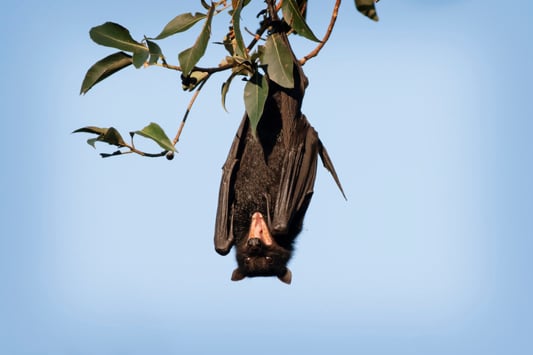Australian bat lyssavirus is a reportable disease.
Australian bat lyssavirus is a zoonotic disease and therefore it is recommended that only appropriately trained and vaccinated people should handle bats wearing appropriate personal protective equipment (PPE).
In Western Australia (WA), there have been no confirmed cases of Australian bat lyssavirus infection in any domestic animals, including horses. Australian bat lyssavirus has been diagnosed in bats in WA. The presence or suspicion of Australian bat lyssavirus must be reported in WA.
Australian bat lyssavirus is a virus that infects Australian flying foxes (fruit bats) and insectivorous bats (microbats). The genus Lyssavirus (‘lyssa’ meaning rage) has 14 different genotypes, which includes rabies virus and Australian bat lyssavirus. Therefore, Australian bat lyssavirus is closely related, but different, to classical rabies virus. Classical rabies virus is not present in Australia.
Australia bat lyssavirus was first detected in Australia in a black flying fox in 1996. Since then, the virus has been isolated in bats in New South Wales, the Northern Territory, Queensland, Victoria, South Australia and Western Australia.
Australian bats are the natural reservoir for Australian bat lyssavirus, and it is present in less than 1% of wild bats, but is more likely to be detected in sick, injured or orphaned bats. In Australia, Australian bat lyssavirus infection has been found in the four common species of flying foxes (Pteropus sp.), in one blossom bat (Syconycteris australis) and in one microbat, an insectivorous yellow-bellied sheathtail bat (Saccolaimus flaviventris).
Humans and domestic animals, including horses, dogs and other pets may be exposed to Australian bat lyssavirus through contact with infected bats. The virus can cause fatal encephalitis (inflammation of the brain) if not promptly treated after potential exposure. In Western Australia, there have been no confirmed cases of Australian bat lyssavirus infection in any domestic animals.
Infection in bats can have a long incubation period, 10-29 days, followed by an acute, progressive and fatal clinical disease manifested as abnormal behaviour and neurological signs.
The following signs in bats should raise a high index of suspicion for Australian bat lyssavirus:
- excitation, agitation and aggression
- paralysis or paresis; inability to fly
- unusual vocalisation and abnormal function of mouth
- convulsions/seizures/tremors
- respiratory difficulties.
Note that apparently healthy bats with normal behaviours may still be infected with Australian bat lyssavirus.
Some endemic diseases can present similarly to Australian bat lyssavirus such as toxoplasmosis and neuro-angiostrongylosis as well as trauma (broken wing bones, spinal or head injuries) and toxicities (e.g. lead toxicity).
Classical rabies is exotic to Australia can also present similarly to Australian bat lyssavirus.
Clinical signs in non-bat species are likely to be similar to those of classical rabies.
Horses that become infected may develop fever, depression and uncoordinated hindlimbs progressing to recumbency. Seizures and difficulty swallowing may also be observed.
Dogs and cats that become infected might develop paralysis of the throat and jaw muscles resulting in foaming at the mouth. Other signs may include:
- disorientation
- incoordination
- staggering caused by paralysis of the hind legs.
The virus can be transmitted from bats to humans or other animals when infected bat saliva enters the body, usually through a bite or scratch or a pre-existing break in the skin (cut or wound). Absorbing infected bat saliva through the eyes, nose and mouth is also possible through aerosol droplets.
The virus is unlikely to survive outside the bat for more than a few hours.
Contact with faeces or urine from a lyssavirus-infected animal is not considered to pose a risk of transmission for Australian bat lyssavirus, therefore, there is no known risk of contracting the virus from bats flying overhead.
Prevention of transmission should be based on avoiding potential contact with bats wherever possible, particularly those showing neurological signs. Only appropriately trained and vaccinated people should handle, rescue or examine a bat wearing appropriate personal protective equipment (PPE).
Keep domestic animals away from where bats are feeding on fruiting or flowering trees or roosting and covering animals’ feed and water troughs.
Humans that have been bitten or scratched by a bat must immediately contact their local medical practitioner or the Department of Health Western Australia, Communicable Disease Control Directorate
Communicable diseases, Department of Health WAThe virus is fatal if not promptly treated after potential exposure.
DO NOT try and capture bats. Only appropriately trained and vaccinated people should handle bats wearing appropriate personal protective equipment (PPE).
AVOID contact with the sick or dead bat, RECORD the time, date and location of the sighting (videos and photos may be helpful), and REPORT immediately.
Humans that have been bitten or scratched by a bat must immediately contact their local medical practitioner or the Department of Health Western Australia, Communicable Disease Control Directorate.

